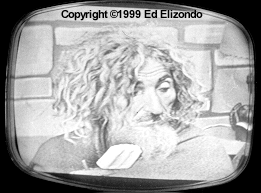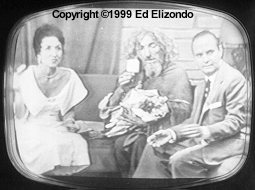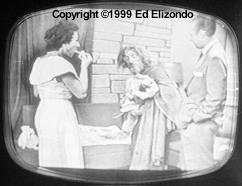 |
El Caballero de París(The Gentleman from Paris)1899-1985 |
|
El Caballero de París ("The Gentleman from Paris") was a well known street person in Habana in the 1950's. He was of medium height, less than 6 feet. He sported long unkempt dark brown hair and beard, with a few white hairs. His fingernails were long and twisted from not being cut in many years. He always dressed in black, covered with a black cloak, even in the summer heat. He always carried a portfolio with papers and a bag where he carried his belongings. He was a gentle man who would appear in the most unlikely places at the most unpredictable times, although he visited many places on a regular schedule. He would walk the streets and ride the buses in Habana greeting everyone and discussing his philosophy of life, religion, politics and current events with everyone that crossed his path. He could regularly be found in the Paseo del Prado; the Avenida del Puerto; in a park near the "Plaza de Armas"; near the Church "Iglesia de Paula"; in the Parque Central, where he sometimes slept on one of the benches; in Muralla street; near Infanta and San Lazaro; and in the corner of 23 and 12 streets in El Vedado. I also remember him walking along the central path of the "Quinta Avenida" (Fifth Avenue) in Miramar, where he usually was in the afternoons. He was a fluent and educated talker. Many still remember the times when they used to chat with him. He never begged or used bad language. He only accepted money from people he knew, who in turn would be given a gift, which could be a postcard colored by him, a pen or pencil decorated with strings of various colors, a pencil sharpener, or similar object. He often would give change to those who gave him money. Although children were initially scared by his appearance, they soon lost their fright and chatted with him. Everyone, adults and children, spoke to him with utmost respect.
Biography and GenealogyThe book by Dr. Calzadilla (see below) contains a wealth of information, some of it conflicting, obtained from interviews with El Caballero, his family and acquaintances. Dr. Calzadilla was the last Psychiatrist who attended El Caballero at the Mazorra Hospital for Mental Illness in the outskirts of Habana. The book contains a photo copy of El Caballero's birth certificate and of the passenger entry list when he arrived in Cuba. It also contains his medical diagnosis, results of laboratory and psychiatric tests and his autopsy report. From these documents we obtain the following facts: El Caballero's real name was José María López Lledín. He was born at 11AM on 30 December 1899 in his father's home in the small town of Vilaseca, in the Municipality of Fonsagrada, Province of Lugo, Spain. His father was Manuel Lopez Rodriguez, age 30, also born in Vilaseca, and his mother was Josefa Lledin Mendez, age 30, born in Negueira in the same Municipality and Province. His paternal grandparents were Bernabe Lopez and Manuela Rodriguez, both previously deceased. His maternal grandparents were Manuel Lledin and Francisca Mendez, both living at the time of his birth. His parents owned a small villa with vinyards where they produced wine and spirits. The book relates that he was baptized in the Parish of Salvador de Negueira . He started his primary schooling at age 7 in Negueira and completed half of his secondary education. One report states that he had been the 4th of 8 children. Another reports that there had been 11 children in the marriage of which 2 had died and 7 emigrated to Cuba. According to his sister Inocencia, José fell in love with Merceditas, the daughter of a doctor in Fonsagrada. She died very young, and José was by her bedside when she died. The day that she died, José swore he would never marry and he always kept his promise. According to the entry documentation (Cuba National Archive - Registry of Passenger Entries in 1913 - Folio 283), José Maria Lopez Lledin arrived in Habana on 10 December 1913 at the age of 12 aboard the German steamship "Chemnitz". There he was united with his uncle (known as AG, a brother in law of his brother Benigno) and his sister Inocencia, who had previously arrived in Cuba in 1910. José worked for a brief time at a grocery store in Genios street, owned by another Galician, until he left his uncle's home to seek his own destiny. He worked as a clerk at a flower shop, a tailor (according to his sister Inocencia), a book store and a lawyer's office. He studied and refined his mannerisms to get better employment and was able to get higher paying jobs working [as a restaurant waiter] in the hotels "Inglaterra", "Telegrafo", "Sevilla", "Manhattan", "Royal Palm", "Salon A" and "Saratoga". According to his cousin Julio, he could even speak some English. "El Caballero" confessed to Calzadilla that he had never married, but had a son and a daughter from a woman who was a secretary of a sugar company. El Caballero relates that his son lived in Marianao and worked in radio, and that the mother and daughter had left Cuba.
Prison and "Birth" of "El Caballero"Most reports agree that José Maria lost his reason and became "El Caballero" when he was arrested in late 1920 and sent to the prision at "El Castillo del Principe" in Habana for a crime he had not committed. His nephew, Manuel, confirms that, according to his aunt Mercedes, sister of "El Caballero", the reason José lost his faculties was that he was jailed for a crime that he did not commit. What is still yet to be determined is the crime he was accused of and how long he was in prison. Neither "El Caballero" nor his family members discussed this point in any of their interviews, other than reiterating his innocence. Apparently none of the reporters in Cuba who wrote stories about "El Caballero" were able to find any record of his arrest and conviction. It is reported that in prison he learned the art of making pens from plumages (the old calligraphy pens). It is stated by several sources that in prison he would give speeches in which he would present himself to other inmates as Pope, King or Caballero. [These two details lead us to believe that he was probably in jail for more than the 30 days sentence usually given for minor offenses.] There are several contradictory theories about why José Maria was arrested [this editor's comments are provided in square brackets]:
No one has been able to precisely determine the crime that he was accused of or how long he remained in prison. When he started wandering the streets of La Habana, his family got together to see what could be done to help him. They decided that the best course of action would be to return him ot his native town to live with his parents. Whey they communicated this decision to El Caballero, he became deeply upset and threatened to jump off the ship and kill himself if they tried to ship him back to Spain. The family desisted in such efforts, but the net result was that "El Caballero" and his family became further estranged.
Other TheoriesThere are several other theories put forth as to why "El Caballero" lost his reason having nothing to do with his time in jail:
Origins of his Nickname"El Caballero" was always vague about the origins of his nickname. Once he stated to his biographer that he got his name from a French novel. Another time he claimed that they started calling him "El Caballero" at "La Acera del Louvre" (the "sidewalk of the Louvre"), an area of the Paseo del Prado where three hotels are located, including the "Inglaterra" where he had worked. Perhaps in his mind he equated the "Acera del Louvre" with Paris. He said Habana was "very Parisienne" and that he was "a Musketeer, a Corsair and a Knight (Caballero) of Lagardiere". He stated that "Paris is well known in Habana" and that "many cubans had become famous in Paris, such as Marta and Rosalia Abreu of Santa Clara". Others say that at one time he worked at the "Paris" restaurant and, when he returned rambling that he was a "Caballero" and "King" the patrons started refering to him as the "Caballero de Paris". Others say it was due to the French styple of dress which he sported in his ramblings. Still others relate that it was givien to him by the weekly humorous/satiric publication "Zig Zag". Both Javier and "El Caballero"'s sister Mercedes state that "El Caballero" got his nickname due to the sweetheart from Paris, who was killed during her trip to join him in Habana. Our own theory of the origin of his nickname (completely unsubstatiated) was that it might be derived from a contemporary French movie in which the main protagonist, also a mild mannered gentleman, had the unenviable profession of being the executioner of Paris, an occupation known since the days of the French Revolution by the euphemistic name "Monsieur de Paris" ("The Gentleman from Paris"). In the movie, the character's occupation was a mystery to his fellow lodgers until his nosy landlady, wondering why he only worked one day a week, looked into his briefcase and found the blade for the guillotine. Life as "El Caballero""El Caballero" wandered the streets of Habana and its suburbs for many years. Everyone who lived in Habana during the 1950's has a favorite anecdote about "El Caballero". Two that I personally remember were:
From Calzadilla's book we learn that, at the start of his wanderings, he still kept clean and well dressed. The book relates that a lady, secretary to the head of a sugar company, educated in France and fluent in 3 languages, took him home to live in her luxurious apartment, bathed and perfumed him and dressed him in silk shirts. She took him to the theater and movies until their photograph appeared in one of the nespapers, at which point, the lady's boss demanded that the relationship be terminated if she wanted to keep her job. She complied. [This lady is perhaps the same lady that "El Caballero" claimed was the mother of his two children, since they both had similar employment. Her name appears in the book but is witheld here for privacy reasons.] According to one of our readers, who used to live in the second story of the building, he used to often sleep in the corner of Infanta and San Lazaro, the building where the "Lamparas Quesada" offices were located. I remember seeing him often on the route 19 and 32 buses traveling between the suburbs of El Vedado and Miramar and Habana city proper. According to the Calzadilla book, "El Caballero" never traveled outside of Habana after he became mentally ill.. Several times he was arrested and once, or maybe twice, he was bathed and his hair was shaved completely, but the reaction of the public when the event was reported by the press, resulted in his immediate release. In 1941 he was briefly interned in the Mental Hospital at Mazorra, but was released immediately by Presidential order. In later years he would spend a great deal of his time at the corner of 12 and 23 in El Vedado where there were several pizza establishments who fed him at no charge. One of our readers, Olga Caicoya, recently (11/2011) sent us this anecdote (which we have translated):
His Family
His cousin Julio names the 7 brothers and sisters of "El Caballero"'s who came to Cuba. They were Inocencia, Isabel ("Cuca"), Manuela, Amancio, Mercedes, Benigno and Antonio. Inocencia died in a nursing home in Habana and was buried in the Cementerio Colon on 12 November 1973. Cuca and Manuela also died in Cuba. Amancio and Mercedes left Cuba. Benigno returned to Spain where he died. His brother Antonio who was physically and mentally ill with depression committed suicide on 20 February 1973. Cuca and Amancio both had children that went to live in the USA. We have recently (2004-2005) corresponded via e-mail with two relatives of El Caballero, his nephew Manuel, and a great-grandson of one of his sisters, Javier (their last names are omitted here for privacy reasons). Manuel told us that El Caballero's uncle, three brothers and two sisters lived in Havana and tried to convince him to stop his vagabond lifestile. El Caballero did not want the family to support him or give him money so he would often fight with them and escape to live alone on the streets of Havana. During that time, he appeared sane and often remembered and spoke of his town and family. As years passed, his "strangeness"' developed into insanity. After the Communist Revolution, the brothers and sisters left Cuba and only El Caballero was left behind. Three of his brothers had descendants, some now living in Chicago and others in Asturias. The only surviving sister of "El Caballero", Mercedes, now living with Manuel in Spain, is now 91 and in perfect mental and physical health. Manuel sent us her photo which we are reproducing below.
El Caballero's sister Mercedes (January 2005)
His final yearsOn 7 December 1977 he was interned in the Mazorra Psychiatric Hospital in the outskirts of Habana, as a humanitarian gesture. The fundamental reason for his internment was not that he was threatening to anyone, but rather his deplorable and deteriorating physical condition. There he was bathed and his hair thoroughtly cleaned and made into a long braid. He was given clean clothes and plenty of food. During his stay at Mazorra he was given physical, laboratory and psychological tests and also suffered a hip fracture as a result of a fall. The diagnosis from his psychatrist, Dr, Calzadilla (which is included in his book) is that he suffered from paraphrenia, sometimes considered a form of schizophrenia. He did not suffer from hallucinations. He died in Mazorra at 1:45 AM on July 11, 1985 at the age of 86. He was initially buried in the cemetery of Santiago de las Vegas in Habana. According to the article by Agence France Presse, his remains were later exhumed by Eusebio Leal, the Historian of the City of La Habana, and transfered to the convent of San Francisco de Asis (now a concert hall and museum), his current resting place.
Legends and InspirationDozens of legends were created about his person, which frequently appeared in the cuban press of the 20th century. They inspired various artists, writers, movie makers and a biography by his doctor, Luis Calzadilla. Some of the more contemporary memorials are are listed below.
photo courtesy of Jorge Calas
Further InformationThe most complete information about "El Caballero" is found in the following biography written by Dr. Luis Calzadilla Fierro, the last of his psychiatrists in the Mazorra mental hospital.
Our TV Photos
The TV photos in this page were taken by the author. They document one of El Caballero's rare appearances in cuban television in 1955, The TV show was likely "Noches de Ambar Motors", a stellar show on the Telemundo network. The hosts were Eduardo Pagés, a Spaniard who was a long time resident of Cuba, and Floreana Alba, an italian artist who remained in cuba after the show "Cabalgata" folded.
Here are some more pictures of the TV show:
Acknowledgements
If you can contribute any additional details, please send me an e-mail at the address below and I will add the information here. - Ed
|
|
|
El Caballero de Paris - Updated
29-Nov-2011
Copyright © 2007-2013 - Ed Elizondo
|
|




